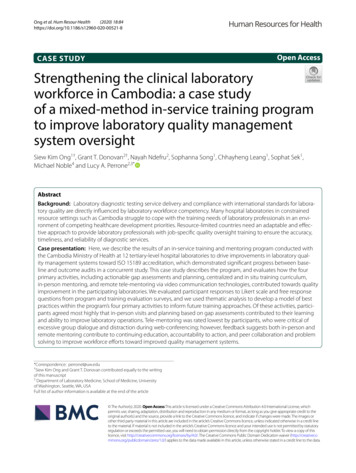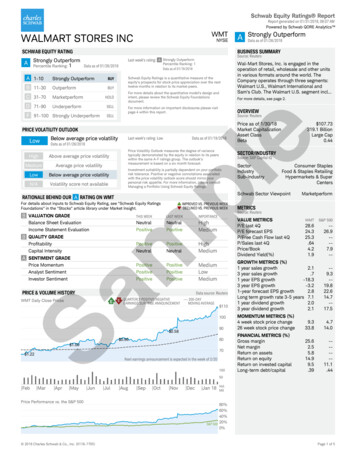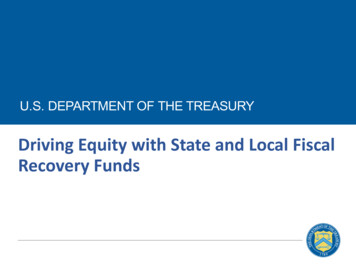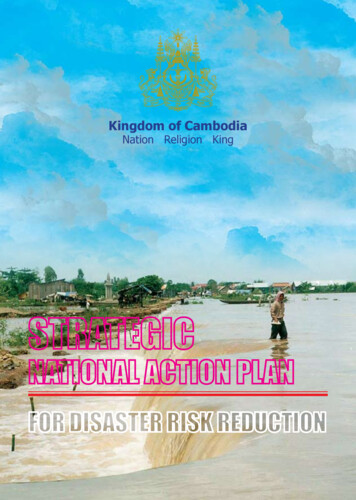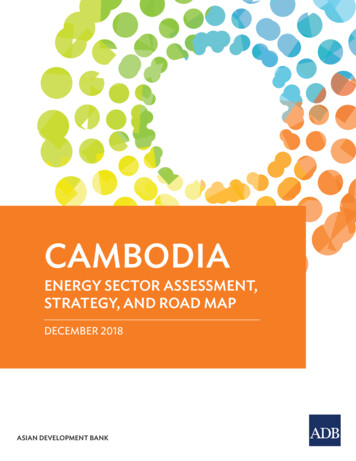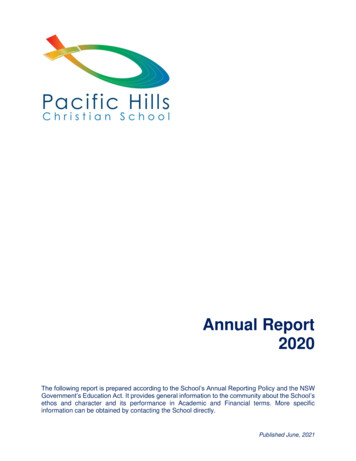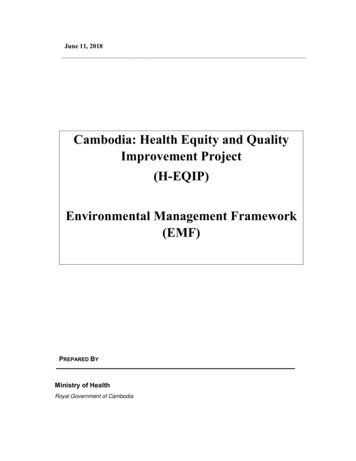
Transcription
June 11, 2018Cambodia: Health Equity and QualityImprovement Project(H-EQIP)Environmental Management Framework(EMF)PREPARED BYMinistry of HealthRoyal Government of Cambodia
Table of Contents1.INTRODUCTION AND BACKGROUND -------------------------------------------- 11.1 INTRODUCTION. 11.2 PROJECT DESCRIPTION . 3COMPONENT 1: Strengthening Health Service . 4Sub-component 1.1: Service Delivery Grants: Health Centers . 4Sub-component 1.2: Service Delivery Grants: Referral Hospitals . 4Sub-component 1.3: Service Delivery Grants: PHDs and ODs . 5COMPONENT 2: Improving Financial Protection and Equity . 5COMPONENT 3: Ensuring Sustainable and Responsive Health Systems . 5Sub-component 3.1: Health System Strengthening . 5Sub-component 3.2: Health Infrastructure Improvements . 6Sub-component 3.3: Project Management, Monitoring and Evaluation . 61.3 OBJECTIVES AND SCOPE OF ENVIRONMENTAL MANAGEMENTFRAMEWORK (EMF) . 72. ENVIRONMENTAL POLICIES AND LEGISLATIVE FRAMEWORK APPLICABLETO THE PROJECT ----------------------------- 83. ENVIRONMENTAL SAFEGUARDS PROCESSING ---------------------------------- 94. BASELINE INFORMATION AND POTENTIALS ENVIRONMENTAL IMPACTS 104.1 Potential Impacts from Health Facility Construction and Rehabilitation . 104.2 Potential Impacts from Drinking Water Quality . 114.3 Health Care Waste Management . 174.4 Wastewater . 214.5 Dengue Vector Control . 224.5.1 Pesticide Use. 224.5.2 Human Health Risks . 224.5.3 Environmental Risks. 235. ENVIRONMENTAL MANAGEMENT PLAN (EMP) ------------------------------- 24
5.1 Generic Environmental Management Plan for Health Care Facility Construction andRehabilitation . 24Asbestos . 255.2 Drinking Water Quality . 255.3 Health Care Waste Management . 275.4 Pesticide Management and Monitoring Plan . 285.4.1 Dengue . 286.INSTITUTIONAL ARRANGEMENTS ---------------------------------------------- 307.MONITORING, SUPERVISION AND REPORTING ---------------------------- 318.SAFEGUARDS RELATED TRAINING AND CAPACITY BUILDINGRECOMMENDATIONS --------------------- 329.PUBLIC CONSULTATION AND DISCLOSURE--------------------------------- 33ANNEX 1: ENVIRONEMENTAL SAFEGUARDS SCREENING CHECKLIST FORM-CAMBODIA HEQIP ------- 34ANNEX 2 – ENVIRONMENTAL CODES OF PRACTICES (ECOPS)------------------------ 36ANNEX 3. GOOD PRACTICE NOTE: ASBESTOS: OCCUPATIONAL AND COMMUNITYHEALTH ISSUES ---------------------------------------- 40
11. INTRODUCTION AND BACKGROUND1.1 INTRODUCTIONIn 2002, the Ministry of Health, with support from the EVS Environment Consultants (EVS),undertook an environmental review (ER) of the Cambodia Health Sector Support Project (HSSP).This was done during Project preparation and included development of an environmentmanagement plan (EMP). In 2008, the ER and EMP were reviewed and revised as part ofpreparation for the Cambodia’s Second Health Sector Support Program (HSSP2), taken intoaccount the Cambodia’s environmental laws, regulations, policies and other relevant legislationto ensure that applicable environmental assessment requirements were fully addressed duringProgram implementation.The 2008 ER assessed potential environmental and human health impacts of the HSSP2,particularly with regard to: (a) construction and rehabilitation of health care facilities (HCF)focusing on operational health care waste management (HCWM) practices, incinerator use,arsenic in groundwater, and extraction of asbestos when present during civil works; and (b)pesticide use in malaria and dengue vector control programs. The HSSP2 triggered the followingsafeguards: Environmental Assessment (OP/BP 4.01), Pest Management (OP 4.09), IndigenousPeoples (OP/BP 4.10), and Involuntary Resettlement (OP/BP 4.12).The EMP is the instrument that describes the safeguards against the main risks: civil works,including asbestos; health care waste management; and pest management. The 2008 HSSP2 EMPrecommends appropriate mitigation measures and monitoring programs to be followed with a view toguiding the Program design and incorporating appropriate management plans during HSSP2implementation.In October, 2013, the First Additional Financing (AF1) for HSSP2 of USD 13.44 million wasapproved. The additional financing was used to scale up the number of health equity funds (HEFs)and service delivery grants ( SDGs) that finance health services as well as fill financing gaps forother activities such as training and operating costs. In September 12, 2014, the SecondAdditional Financing (AF2) of US 12.69 million was approved. The AF2 was used to fillfinancing gap for HEFs and SDGs for approximately nine months from the fourth quarter of 2014to the second quarter of 2015. In November 6, 2015, the Third Additional Financing (AF3) of12.14 million was approved. The AF3 is being used to: (a) cover a financing gap for an additional11 months from August 1, 2015 to June 30, 2016, for the Service Delivery Grants (SDGs) inexisting 36 Special Operating Agencies (SOAs); and (b) scaling up of Health Equity Funds(HEFs) from 61 to all 88 Operational Districts (ODs) in the country.AF1, AF2 and AF3 triggered the same policies as the Original Project. As part of the preparationfor AF3, the EMP of AF2 has recently been updated in July 2015 to reflect findings andrecommendations made by the partial environmental assessment carried out in January 2015 andlessons learned during safeguards implementation of HSSP2, AF1 and AF2. EMP has beenattached with bidding documents to inform contractors and engineers about their responsibility tocomply with required safeguard policies and tools. The task team paid close attention tomonitoring the Project implementation and found that the environmental adverse impacts wereminimal and site specific. These were mitigated through applying good construction and goodconstruction management practices. Implementation of safeguard policies under HSSP2 and AF1
2and AF2 has been satisfactory. The HSSP2 closing date has been extended twice from June 30,2014 to December 31, 2015 to allow adequate time for completion of remaining civil works andprocurement of medical equipment from the original project and to June 30, 2016 for bridgingfinancing support of implementation of Health Strategic Plan 2008-2015 and Health StrategicPlan 2016-2020, which will be launched in March 2016.In May 2016, the Health Equity and Quality Improvement Project (H-EQIP), built upon theinnovations and achievements supported and scaled up in the HSSP and HSSP2 was approved bythe World Bank Board of Executive Directors and became effective in November 2016. Duringthe preparation of H-EQIP, the Ministry of Health (MOH) had prepared an EnvironmentalManagement Framework (EMF) to address potential impacts arising from project implementationand operation. The EMF outlines procedures for screening all proposed sub-projects/investmentfor their potential adverse environmental impacts, specific measures for managing and monitoringimpacts and training and capacity building arrangements needed to implement the EMFprovisions. It also includes a generic Environmental Management Plan and Environmental Codeof Practices, Health Care Waste Management Plan and Pest Management Plan. The final EMFhad been publicly disclosed on the MOH’s website and the World Bank’s website in April 01,2016 and April 11, 2016, respectively.In June 2018, nineteen months since H-EQIP project effectiveness, an additional financing (AF)is proposed. The AF would support the supply side readiness and availability of key services thatare or will be integrated into the expanded HEF benefit package, with a focus on noncommunicable diseases including cervical cancer screening and treatment, diabetes andhypertension screening and treatment. Long-term family planning services will also be supported.This will be done through three additional new DLIs under Component 3 (subcomponent 3.1): (a)new DLI on availability and utilization of cervical cancer screening and treatment services; (b)new DLI on availability and utilization of diabetes and hypertension screening and treatmentservices; and (c) new DLI on availability and utilization of long-term family planning services.As with the original project, the AF will be national in scope and coverage. However, theadditional financing will not include supports to any civil works.No changes are anticipated with regard to environmental and social safeguards policy triggers aspart of the AF. The project remains an environmental category “B” and triggers twoenvironmental safeguards policies: OP/BP 4.01 (Environmental Assessment) and OP/BP 4.09(Pest Management). The AF does not include any additional physical construction; therefore, itwill not have incremental impacts from civil works. Environmental risk from the AF is consideredModerate. This is because the AF will promote non-communicable diseases prevention andtreatment as well as increase utilization of log-term family planning commodity which maygenerate small incremental amount of healthcare wastes. Under the AF, health centers may useparts of the three new DLIs (DLI-7, DLI-8 and DLI-9) funds for outreach activities which includeusing larvicides for dengue control. These activities are not expected to have significant adverseand unprecedented environmental impacts.Experiences from on-going implementation of the original H-EQIP project confirm that no majorenvironmental and social impacts are noted/anticipated. The sites study, land titles review andsocial and environmental screening for construction of health facilities indicated that thecorresponding environmental and social impacts were minimal, limited to construction sites,temporary and limited to the construction phase. These impacts will be mitigated through the
3EMP, including ECOPs. The EMP and ECOPs will include provisions for Asbestos management.The impacts will be monitored by the construction supervision firm, the MOH and the Bank’stask team. The AF will not include support for civil works.Health Care Waste (HCW) generated from increased utilization of health services under theoriginal H-EQIP project has been managed through the MOH’s comprehensive guidelines oninfection prevention and control, which include guidelines on health care waste management, andthe EMF. Training on the Guidelines has been provided to health facility staff all over Cambodiaby the MOH. The strong focus of the original project to improve quality of service delivery,including improving health care waste management as part of improving infection prevention andcontrol, has resulted in improvement of health care waste management and hygiene and sanitation.Compliance with the guidelines will be continued to monitor regularly through the ServiceDelivery Grant mechanism/National Quality Enhancement Monitoring Process (NQEMP), whichis being conducted on a quarterly basis.The EMF including a generic Environmental Management Plan and Environmental Code ofPractices, Health Care Waste Management Plan and Pest Management Plan remain pertinent forthe original project and the AF activities and will be re-disclosed prior to the AF appraisal.1.2 PROJECT DESCRIPTIONThe H-EQIP will build on the innovations supported in the Second Health Sector Support Program(HSSP2), particularly HEFs and SDGs, and aims to increase the sustainability of theseinnovations by improving their resourcing and management as envisaged in the RGC’s HSP-3. Itwill further strengthen the results-based focus of both HEFs and SDGs with a specific goal ofimproving quality of health service delivery and utilization of services by the poor. In addition,the Project will use a multi-pronged approach to strengthening health systems, especially tosupport improvements in quality of care, by focusing on enhancing provider knowledge throughboth pre-service and in-service training, improved availability of critical infrastructure in healthfacilities, and strengthening Public Financial Management (PFM). Using a set disbursementlinked indicators (DLIs), the Project will disburse funds against targets achieved on these healthsystem strengthening measures. Another key strategic shift is to attain institutional sustainabilitythrough a transfer of responsibility for third party HEF verification from an internationallyrecruited firm to an independent Government agency which will be established by June 2018, andextending this responsibility to include verifying SDG results at all levels of the health system.Project Component DescriptionsThe H-EQIP will build on the innovations supported in the Second Health Sector Support Program(HSSP2), particularly HEFs and SDGs, and aims to increase the sustainability of theseinnovations by improving their resourcing and management as envisaged in the RGC’s HSP-3. Itwill further strengthen the results-based focus of both HEFs and SDGs with a specific goal ofimproving quality of health service delivery and utilization of services by the poor. In addition,the Project will use a multi-pronged approach to strengthening health systems, especially tosupport improvements in quality of care, by focusing on enhancing provider knowledge throughboth pre-service and in-service training, improved availability of critical infrastructure in healthfacilities, and strengthening Public Financial Management (PFM). Using a set disbursement-
4linked indicators (DLIs), the Project will disburse funds against targets achieved on these healthsystem strengthening measures. Another key strategic shift is to attain institutional sustainabilitythrough a transfer of responsibility for third party HEF verification from an internationallyrecruited firm to an independent Government agency which will be established by June 2018, andextending this responsibility to include verifying SDG results at all levels of the health system.COMPONENT 1: Strengthening Health ServiceThis Component will expand the current SDGs into a mechanism for providing performancebased financing to different levels of the Cambodian primary and secondary health system basedon achievement of results. The SDGs at health centers and hospitals will be performance-linkedagainst delivery of a basic and comprehensive package of services. This will include criticalreproductive, maternal, neonatal, child and adolescent health services. Nutrition will also be oneof the indicators prioritized covering early breast feeding, vitamin A supplementation,deworming, iron folic acid supplementation and growth monitoring.The Project aims to use performance-based payments under SDGs to complement the RGC’sproposed fixed grants to health facilities, particularly by streamlining the funds flow and reportingarrangements envisaged for the same. These new lump-sum grants will form part of the SDGsystem through joint Prakas to be issued by the Ministry of Economy and Finance (MEF) andMOH, and are intended as a complement to the facilities’ operational budget.Sub-component 1.1: Service Delivery Grants: Health CentersThe Project will provide SDGs to HCs to help finance the MPA of HCs. The amount and paymentof the grants will be based on the utilization (i.e. quantity) of services provided and on the qualityof services. Initially, the OD, with its HCs will be considered as one unit and will implement thejoint Prakas issued by the MOH specifying services to be provided. The quantity and quality ofservice delivery by the HCs, including utilization by the poor and vulnerable will besystematically determined by the respective OD through a new, standardized supervision checklistto be detailed in the updated SDG manual, and applied quarterly. The results would be crosschecked and verified by an independent agency (initially by the Health Equity Fund Implementer,HEFI, and, after its establishment, by the independent government agency acting as a paymentcertification agency (PCA) proposed for HEFs. Once the results have been verified, the MOH willinform MEF to make relevant SDG payments. Eligible categories of expenditure for SDGs at theHC level would include minor works, goods, and emergency purchase of drugs and/or recurrentcosts including supplies, short term staff, consumables, communications, maintenance,transportation, accommodations, training, other incidental expenses and performance bonuses forhealth workers.Sub-component 1.2: Service Delivery Grants: Referral HospitalsThis sub-component aims to incentivize improvements in the quality of care at the secondarylevel, improve performance in capacity building activities for in-service and pre-servicecandidates, and promote utilization of services by HEF beneficiaries. Using a new standardizedsupervisory checklist, to be included in SDG Manual, hospitals will be measured quarterly ontheir performance on structure, process, and outcomes. Structural measures will comprise the
5context in which care is delivered, including infrastructure, staff, financing and equipment.Process measures will include the technical and interpersonal process and actions that make uphealth care as reflected in the transactions between patients and providers and staff throughout thedelivery of health care. Facilities will also be encouraged and rewarded for initiating qualityimprovement processes including self-assessments of quality and patient safety, continuousquality improvement, peer to peer evaluations and adverse event audits. Outcomes refer to theeffects of health care on the status of patients and populations and will be considered to be a resultof inputs and processes of care. The results would be cross-checked and verified by theindependent agency (initially the HEFI and subsequently the PCA). Eligible categories ofexpenditure for SDGs at the hospital level are similar to health centers and include minor works,goods, drugs and/or recurrent costs including supplies, short term staff, consumables,communications, maintenance, transportation, accommodation, other incidental expenses as wellas performance bonuses for health workers.Sub-component 1.3: Service Delivery Grants: PHDs and ODsThese SDGs aim to strengthen the management of ODs and PHDs. The performance of ODs andPHDs will be measured every six months by the Quality Assurance Office (QAO) of MOH,against their self-reported activities on a score card to be detailed in the SDG Manual, measuringkey supervisory processes and health system outputs. These include: (i) timely completion ofquality checklists for health facilities in their jurisdiction; (ii) contribution to capacity buildingactivities for in-service and pre-service training; (iii) drug stock outs in health facilities, humanresources availability; (iv) Health Management Information System (HMIS) reports submitted;(v) quarterly review meetings and system functionality. Similar to the other SDG grants, theproposed independent PCA would verify the PHDs’ and ODs’ performance. Eligible SDGcategories of expenditure for ODs and PHDs will include minor works, goods, and/or recurrentcosts including supplies, short term contracts, consumables, communications, maintenance,transportation, accommodation, other incidental expenses as well as performance bonuses.COMPONENT 2: Improving Financial Protection and EquityThis component will continue to support the HEF system and co-finance with the RGC the costof health services for the poor. The current HEF system is expected to evolve with changes inGovernment policy on beneficiaries and benefit packages and social health protection. Voucherswill be fully integrated into the HEF. This component would build on the current success of theHEF system, aiming to improve the quality of services, increase utilization by the poor, and ensuresustainability by transferring implementation responsibility to the RGC.COMPONENT 3: Ensuring Sustainable and Responsive Health SystemsSub-component 3.1: Health System StrengtheningThis sub-component will support a program of activities designed to improve supply sidereadiness and strengthen the institutions that will be implementing project activities. Thisincludes the implementation of comprehensive pre-service and in-service training programs forhealth workers, equipment of health facilities to meet minimum standards for the provision ofobstetric and neonatal care, carrying out of enhanced health service quality monitoring, improvedtimeliness of SDG and HEF payments, and establishment of sustainable health service purchasingarrangements.Financing for this sub-component will be provided based on results tracked by DLIs, which are aset of tracer indicators with annual targets, aimed at measuring performance against health systemstrengthening actions.
6In June 2018, an additional financing (AF) is proposed to support the supply side readiness andavailability of key services that are or will be integrated into the expanded HEF benefit package,with a focus on non-communicable diseases including cervical cancer screening and treatment,diabetes and hypertension screening and treatment. Long-term family planning services will alsobe supported. This will be done through three additional new DLI indicators under Subcomponent 3.1. As with the original project, the AF will be national in scope and coverage.Sub-component 3.2: Health Infrastructure ImprovementsApproximately US 13 million from Component 3 is expected to finance civil works as perpriorities identified by MOH in their civil works plan 2016-2020. Prioritization will be based onaccess issues, attention to remote areas, concerns around patient safety and improving maternaland neonatal survival. A joint assessment with RGC, to identify priorities for infrastructureinvestments, will be undertaken and the final list of civil works will be identified in the first halfof 2016. The expected type of investments will include maternity wards and other infrastructurefor emergency maternity and neonatal services, HCs and hospitals.Sub-component 3.3: Project Management, Monitoring and EvaluationProject management will be integrated into the responsible departments of the MOH. ThisComponent will support provision of technical and operational assistance for the day-to-daycoordination, administration, procurement, financial management, environmental and socialsafeguards management, and monitoring and evaluation of the Project, including the carrying outof financial audits of the Project. The subcomponent will also support capacity strengthening ofresponsible departments within the MOH to smoothly transfer the responsibility of projectmanagement from the currently existing Secretariat under HSSP2 to the relevant departments, aswell as to support other implementation needs.A technical assistance (TA) grant from the Japan Policy and Human Resources Development(PHRD) Trust Fund, a programmatic Trust Fund administered by the World Bank, of an amountof US 1 million will provide complementary financing to Component 3. The grant is expected tocontribute to the strengthening of Cambodia’s Health Information System to ensure availabilityof relevant, timely and high quality health and health-related data to allow for evidence-basedpolicy formulation, decision-making and management and planning. Support will be provided infour areas: (i) support for upgrading the HMIS including development of policy/regulation,protocols/guidelines and reporting system; (ii) TA to improve data management, analysis,interpretation, reporting, use, and dissemination (at central and decentralized levels); (iii)strengthening medical record systems including expansion of Patient Medical RegistrationSystem database; and (iv) enhancement and integration of disease surveillance and responsesystems (communicable diseases as well as non-communicable diseases). This financing has beenapproved in principle but will become available upon formal endorsement by the JapaneseGovernment and the PHRD Unit and will be funded by Japan PHRD Trust Fund under itsPerformance and Results with Improved Monitoring and Evaluation window. The AF willfinancing the increased support to results monitoring and program management.COMPONENT 4: Contingent Emergency ResponseThe objective of the contingent emergency response component, with a provisional zeroallocation, is to allow for the reallocation of financing in accordance with the IDA ImmediateResponse Mechanism in order to provide an immediate response to an eligible crisis oremergency, as needed.
71.3 OBJECTIVES AND SCOPE OF ENVIRONMENTAL MANAGEMENTFRAMEWORK (EMF)Many of the activities to be supported under this Project will be continuation and/or expansion ofsupport currently being provided by the Second Health Sector Support Program (HSSP2) underthe responsibility of the Ministry of Health (MoH). The expected type of investments includeadditional maternity wards, and other infrastructure to existing health facilities to facilitateemergency maternity and neonatal services, , reconstruction of debilitated existing health centers,expansion of two existing hospitals and repairs/installations of small on-site utilities e.g.incinerators. The number and types of health facilities to be constructed under the project andtheir initial costs have been identified during appraisal stage. The final list of civil works will beconfirmed after the joint assessment on infrastructure investments conducted, and specific costsand detailed engineer design will be conducted in the first half of 2016. Sites forrepairs/installations of small on-site utilities will be identified during the project implementation.These activities link to site specific and temporary impacts from construction of civil works andimpacts from incremental health care waste from health service delivery supports. In line with theWorld Bank operational policy on environmental assessment, the project has been proposed ascategory B since the anticipated impacts are site-specific, temporary and can be mitigated whengood mitigation measures are followed. Since specific sites for civil works has not been finalized,the EMF had been developed by the MoH as part of H-EQIP project preparation process to addresspotential impacts arising from project implementation and operation and in line with the relevantWorld Bank Safeguards Policies, and Cambodia environmental and health regulations. This EMFbuilds on the EMP updated in July 2015 for the Third Additional Financing for HSSP2. Socialsafeguards document i.e. Resettlement Policy Framework (RPF) and Indigenous PeoplesPlanning Framework (IPPF) are prepared separately to manage potential social impacts fromproject activities.Key objectives of the EMF are to: Establish procedures for screening all proposed sub-projects/investments for theirpotential adverse environmental impacts;Specify measures for managing, mitigating and monitoring environmental impacts duringproject operation; andOutline training and capacity-building arrangements needed to implement the EMFprovisions.
82. ENVIRONMENTAL POLICIES AND LEGISLATIVE FRAMEWORKAPPLICABLE TO THE PROJECTRELEVANT LEGISLATION ADDRESSING ENVIRONMENTAL HEALTH ISSUES Sub-decree on solid waste management, 1999; Declaration (Prakas) on Health-Care Waste Management, 2009; National Infection Control Policy, 2009; National Strategic Plan for Infection Control in Health Facilities, 2011-2015; National Guideline on Health Care Waste Management, 2012; Infection Prevention and Control Guidelines for Health Care Facilities, 2010; Law on Environmental protection and natural resources management, 1996 Law on Protected Area Management, 2008; Sub-decree on EIA Process, 1999 Declaration on General Guideline for conducting IEIA/EIA Reports, 2009 Declaration on the Power of the Delegation to the decision making on Project developmentfor Environmental Provincial Department, 2005WORLD BANK GROUP SAFEGUARD POLICIES AND REGULATIONSAPPLICABLE TO THE PROJECT Environmental Assessment (EA) (Operational Policy (OP)/Bank Procedure (BP)4.01); Pest Management (OP 4.09); Indigenous Peoples (OP/BP 4.10); Involuntary Resettlement (OP/BP 4.12); Public Consultations and Information Disclosure; and The World Bank Group Good
original H-EQIP project has been managed through the MOH's comprehensive guidelines on infection prevention and control, which include guidelines on health care waste management, and the EMF. Training on the Guidelines has been provided to health facility staff all over Cambodia by the MOH.


